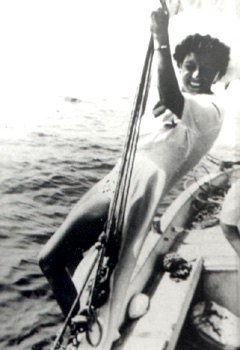
Sail Number:
Type: Yawl
LOA: 72’6” / 22.10m – LOD: 72’6” / 22.10m – LWL: 50’10” / 15.50m – Beam: 15’5” / 4.70m – Draft: 10’6” / 3.20m – Displacement: 35 tons – Ballast: – Hull material: Wood – Sail Area: 365 m² – Designer: Henry Rasmussen – Built by: Abeking & Rasmussen – Year Launched: 1912 – Current Name: La Fiamma Nera – Original Owner: Baron Von Dazur Hannover – FLAG: Italy (IT) – Location:
Historical:
“Konigin II” was designed in 1912 by Henry Rasmussen for Baron Von Dazur Hannover. After spending the First World War in the port of La Maddalena, the Fascist hierarch Alessandro Parisi Nobile, a faithful friend of the Duce, bought it in 1935 and renamed her FIAMMA NERA and gave it to Benito Mussolini. The Duce, as we know, was an aviator amongst many other things, but he was not a seaman, he primarily used the vessel for his secret meetings with his lover Claretta Petacci without ever straying too far from the coast.

After the Liberation of the Allies (8 September 1943) and nearly a decade of his liaisons with his mistress, the owner decided to sink the “Black Flame” in the waters of the Gulf of Tigullio in front of Rapallo to prevent her from falling into the hands of the Nazis. The vessel remained on the Ligurian seabed until the postwar years, when it was recovered by Count Sereni,” who renamed her “Serenella”.
After the war she was recovered by Prince Cremisi and renamed her “Estrela de Guaruja” – star of Guaruja, a city in Brazil and then she became the training ship of the Circolo della Vela di Roma.
To complete her story the vessel remained moored in Fiumicino until 1962 and used as a training ship by the Circolo della Vela di Roma. In the 70s it was bought by the engineer Fonsi who took it to sail in the Adriatic . In 2002 it reappeared in precarious conditions in Viareggio where it returned to its former glory and was also equipped with the most modern instruments thanks to a project by three friends: Augusto Gori, Carlo Meccheri di Pietrasanta and Giorgio Mazzoni. In the same year she took part in the Vele d’Epoca di Imperia and was hired by Cts Ambiente for a dolphin monitoring campaign in the Tyrrhenian Sea, until the last restoration (2006-2010) in Fiumicino.
Restoration
Massimo Paperini – Yacht Designer – The boat has undergone several restorations. In the first intervention in 2002 the clipper bow was removed, added in a false way in the thirties, the portholes were removed, the teak deck rebuilt, the deckhouse restored, some ordered ones replaced together with the mast and moorings, in a first attempt to return the boat to the original design.
From that year on, the boat, after a series of changes of owner and names, returned to its original name: Konigin II.
In 2006 the boat returned to the shipyard in Sanremo where it underwent further interventions.

The restoration and reconstruction carried out by Massimo Paperini’s Duck Design studio is therefore the third in chronological order carried out on the boat.
A first phase of the work consisted of an in-depth analysis of the original drawings of the Abeking & Rasmussen shipyard, which were completely redesigned by the Duck Design studio; in fact, there were no images or references of the details of the original state of the boat, but only the drawings of the original project kindly provided by the shipyard.
This first phase was followed by a phase of study and research on texts and images to get to know the stylistic characteristics of the time and the boats of the same period produced in Northern Europe.
The restoration therefore, which began with a total removal of the interior and all existing bulkheads, aimed at rebuilding the boat to bring it back to its original state. The only variation made to meet the new owner’s needs is the positioning of a second bathroom located in the same space as the original one; the original layout, in fact, preserved in its entirety, included a master cabin, two guest cabins, dinette, kitchen and a single bathroom.
The materials used were: kaya mahogany worked with classic frames and wood paneling, alternating glossy exposed essence and white lacquering; this made it possible to restore brightness to all the interiors, with a correct alternation of light surfaces and wood typical of the boats of the period.
Details in brass and bronze are added such as the handles of the drawers, those of the doors, the lamps and fabrics that have been chosen in a manner consistent with the age of the boat, the sofas in the dinette and the owner’s cabin in capitonnè burgundy leather, the friezes for the ventilation of the rooms that reproduce a typical design of the time.
The technological systems, such as air conditioning, have been carefully hidden.
The works were carried out at the Dod Yachts Shipyard and directed by the owner’s Project Manager Maurizio Di Blas.
Provenance (The Wall of Remembrance – The Owners, Crew & Notable Guest):
Owner/Guardian: (1912) – Baron Von Dazur Hannover (Konigin II)
Owner/Guardian: (1931) – Alessandro Parisi Nobile, (friend of Benito Mussolini), renamed Fiamma Nera.
Owner/Guardian – Count Sereni, renamed Serenella
Owner/Guardian: (1956) – Prince Cremisi, renamed Estrella do Guaruja
Owner/Guardian – Circolo della Vela, Rome (used as a training ship)
Owner/Guardian – Salvatore Squillante

